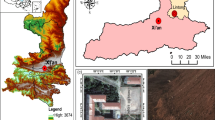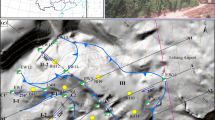Abstract
Lvliang airport is a typical loess filling engineering located in 20.5 km north of Lvliang City in Shanxi Province, China. By the end of March 2012, 14 fissures extending more than 7.5 m were observed in a loess-filled slope, of which the longest fissure is up to 82 m. Field monitoring and laboratory tests have been performed to investigate the slope failure modes. The test program includes wetting tests on unsaturated compacted samples and stress path tests on saturated samples. Field monitoring and observations show that differential settlement caused by non-homogeneity in compacted loess density might lead to the formation of fissures in the loess-filled slope. It was founded that the wetting deformation contributed to the development of differential settlement. Fissures are the essential factor for the loess-filled slope failure. Four deformation stages exhibit in the loess-filled slope prior final failure including development of the fissures, softening of the compacted loess, creeping of the slope leading edge and fissuring of the trailing edge and formation of the through-sliding surface. Development of the sliding surface mainly includes upward and downward expansion of the fissures. Upward expansion is a wetting failure process in loading condition, while downward expansion is a load-off wetting process. In addition, development of the sliding surface is accelerated by softening of the compacted soils as a result of water infiltration. Therefore, the key for taking countermeasures against filling landslides is to monitor and control the development of differential settlement and fissures in the slope shoulders. Digging out and extra-filling the fissures are an effective way for preventing these landslides.














Similar content being viewed by others
References
Censi P, Bonomo S, Cuttitta A, Mazzola S, Patti B, Bonanno A (2009) Marine environmental status in the strait of sicily close to the Gela reclamation site. Epidemiol Prev 33:51–56
Chen C, Zhang D, Zhang J, Zhang W (2017) Compression and wetting deformation behavior of intact loess under isotropic stresses. Rock Mech Rock Eng 36(7):1736–1747
Feng SJ, Shi ZM, Shen Y, Li LC (2015) Elimination of loess collapsibility with application to construction and demolition waste during dynamic compaction. Environ Earth Sci 73(9):5317–5332
Gu T, Wang J, Fu X, Liu Y (2015) GIS and limit equilibrium in the assessment of regional slope stability and mapping of landslide susceptibility. Bull Eng Geol Environ 74(4):1105–1115
Haeri SM, Zamani A, Garakani AA (2012) Collapse potential and permeability of undisturbed and remolded loessial soil samples. Springer, Berlin, pp 301–308
Hall LA (1989) The effects of dredging and reclamation on metal levels in water and sediments from an estuarine environment off Trinidad, West Indies. Environ Pollut 56(3):189–207
Isozaki Y (1994) Yunoki M (ed) Regional development of Awaji Island: land creation in the 21th century. Sandai Hogaku 21:93–101
Jiang M, Li T, Thornton C, Hu H (2016) Wetting-induced collapse behavior of unsaturated and structural loess under biaxial tests using distinct element method. Int J Geomech 17(1):06016010
Jie Z, Sisi Z, Qi P, Qiang YX (2014) Liquefaction analysis of the sandy foundation of revetment structure in a large-scale marine reclamation land project. Electron J Geotech Eng 19:2849–2862
Jin Z (2014) The creation of sfarmland by gully filling on the loess plateau: a double-edged sword. Environ Sci Technol 48(2):883–884
Lei XY (1987) The porosity type and collapsibility of Chinese loess. Sci China (Ser.B) (12):1309–1318 (in Chinese)
Li M (2014) Predictive environment carrying capacity assessment of marine reclamation by prediction of multiple numerical model. IERI Procedia 8:101–106
Li PY, Qian H, Wu JH (2014) Environment: accelerate research on land creation. Nature 510(7503):29–31
Lie H, Cho CH, Lee S, Kim ES, Koo BJ, Noh JH (2008) Changes in marine environment by a large coastal development of the Saemangeum reclamation project in Korea. Ocean Polar Res 30(4):475–484
Liu Y, Li Y (2014) Environment: China's land creation project stands firm. Nature 511(7510):410
Liu Z, Liu F, Ma F, Wang M, Bai X, Zheng Y (2015) Collapsibility, composition, and microstructure of loess in China. Can Geotech J 53(4):1364–1376
Maswoswe J (1985) Stress paths for compacted soil during collapse due to wetting. Ph.d. thesis University of London
Menon M, Jia X, Lair GJ, Faraj PH, Blaud A (2015) Analysing the impact of compaction of soil aggregates using X-ray microtomography and water flow simulations. Soil Tillage Res 150(3):147–157
Mochalov IP, Vinogradova GN (1969) Progress of deformations in intensely sagging loess grounds in the course of wetting. Soil Mech Found Eng 6(3):204–206
Ng CWW, Sadeghi H, Jafarzadeh F (2016) Compression and shear strength characteristics of compacted loess at high suctions. Can Geotech J 54(5):1–53
Ohkura Y (2003) The roles and limitations of newspapers in environmental reporting. Case study: Isahaya bay land reclamation project issue. Mar Pollut Bull 47(1–6):237
Wang JD, Hui YH (2002) Landslides in crows induced by irrigated water in loess area. Sci Geogr Sin 22(3):305–310 (in Chinese)
Wang JD, Zhang ZY (1999) A study on the mechanism of high-speed loess landslide induced by earthquake. Chin J Geotech Eng 21(06):670–674 (in Chinese)
Wang JD, Bai MX, Xiao SF (2001) A study on compound mechanism of earthquake-related sliding displacements on gently inclined loess slope. Chin J Geotechn Eng 23(4):445–449 (in Chinese)
Wang G, Suemine A, Schulz WH (2010) Shear-rate-dependent strength control on the dynamics of rainfall-triggered landslides, Tokushima prefecture, Japan. Earth Surf Process Landf 35(4):407–416
Wang JD, Gu TF, Xu YJ (2017a) Field tests of expansive soil embankment slope deformation under the effect of the rainfall evaporation cycle. Appl Ecol Environ Res 15(3):343–357
Wang JD, Zeng YJ, Xu YJ, Feng KQ (2017b) Analysis of the influence of tunnel portal section construction on slope stability. Geol Ecol Landsc 1(1):56–65
Wu K, Ni WK, Liu K, Shi BY, Guo YX (2016) Analysis on compression deformation of remolded loess based on secant-modulus method. Int J Earth Sci 9(6):2568–2576
Xu L, Coop MR (2017) The mechanics of a saturated silty loess with a transitional mode. Géotechnique 67(7):581–596
Xu L, Dai F, Tham LG, Tu XB, Min H, Zhou YF, Wu CX, Xu K (2011) Field testing of irrigation effects on the stability of a cliff edge in loess, North-west China. Eng Geol 120:10–17
Xu L, Dai FC, Gong QM, Tham LG, Min H (2012) Irrigation-induced loess flow failure in Heifangtai Platform, North-West China. Environ Earth Sci 66:1707–1713
Xu L, Dai FC, Tu XB, Tham LG, Zhou YF, Iqbal J (2014) Landslides in a loess platform, North-west China. Landslides 11(6):993–1005
Xu L, Coop MR, Zhang MS, Wang GL (2018) The mechanics of a saturated silty loess and implications for landslides. Eng Geol 236:29–42
Yan HK, Wang N, Yu TL, Fu Q, Liang C (2013) Comparing effects of land reclamation techniques on water pollution and fishery loss for a large-scale offshore airport island in Jinzhou bay, Bohai sea, China. Mar Pollut Bull 71(1–2):29–40
Yin YP, Huang B, Chen X, Liu G, Wang S (2015) Numerical analysis on wave generated by the Qianjiangping landslide in three gorges reservoir, China. Landslides 12(2):355–364
Yin X, Chen L, He J, Feng X, Zeng W (2016) Characteristics of groundwater flow field after land creation engineering in the hilly and gully area of the Loess Plateau. Arab J Geosci 9(14):646
Yin Y, Xing A, Wang G, Feng Z, Li B, Jiang Y (2017) Experimental and numerical investigations of a catastrophic long-runout landslide in Zhenxiong, Yunnan, southwestern China. Landslides 14(2):1–11
Yuan K (2015) The study of collapsible for intact loess and remolded loess. International Conference on Mechatronics, Electronic, Industrial and Control Engineering. 3975-3987
Zhang D, Wang G, Luo C, Chen J, Zhou Y (2009) A rapid loess flowslide triggered by irrigation in China. Landslides 6(1):55–60
Zhang F, Liu G, Chen W, Liang S, Chen R, Han W (2012) Human-induced landslide on a high cut slope: a case of repeated failures due to multi-excavation. J Rock Mech Geotech Eng 4(4):367–374
Zhang F, Wang G, Kamai T, Chen W, Zhang D, Yang J (2013) Undrained shear behavior of loess saturated with different concentrations of sodium chloride solution. Eng Geol 155(6):69–79
Zhang FY, Pei XJ, Chen WW, Liu G, Liang S (2014a) Spatial variation in geotechnical properties and topographic attributes on the different types of shallow landslides in a loess catchment, China. Eur J Environ Civ Eng 18(4):470–488
Zhang F, Wang G, Kamai T, Chen W (2014b) Effect of pore water chemistry on undrained shear behaviour of saturated loess. Q J Eng Geol Hydrogeol 47:201–210
Zhang F, Kang C, Chan D, Zhang X, Pei X, Peng J (2017) A study of a flowslide with significant entrainment in loess areas in China. Earth Surf Process Landf 42:326–337
Zhao Y-j, Li M-c, Li G-l, Jiao R-h, Cao Y-y (2014) Distribution and trend analysis of din in marine environment waters under reclamation. Adv Mater Res 864-867:1000–1003
Zhu CH, Li N, Liu MZ, Wei YF (2013) Spatiotemporal laws of post-construction settlement of loess-filled foundation of Lvliang Airport. Chin J Geotech Eng 35(2):293–301
Acknowledgments
We sincerely appreciate the constructive comments of the anonymous reviewers.
Funding
The research presented in this paper was funded by the State Key Program of National Natural Science Foundation of China (Grant No. 41630639, 41372329).
Author information
Authors and Affiliations
Corresponding author
Rights and permissions
About this article
Cite this article
Wang, J., Xu, Y., Ma, Y. et al. Study on the deformation and failure modes of filling slope in loess filling engineering: a case study at a loess mountain airport. Landslides 15, 2423–2435 (2018). https://doi.org/10.1007/s10346-018-1046-5
Received:
Accepted:
Published:
Issue Date:
DOI: https://doi.org/10.1007/s10346-018-1046-5




